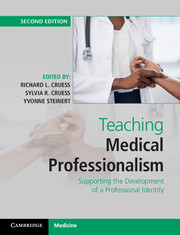Book contents
- Frontmatter
- Contents
- List of contributors
- Foreword
- Introduction
- Part I What is to be taught and learned
- Part II Theory
- 3 Theoretical insights into the nature and nurture of professional identities
- 4 Socialization, professionalism, and professional identity formation
- 5 Educational theory and strategies to support professionalism and professional identity formation
- 6 Role modeling and mentoring in the formation of professional identity
- 7 Experiential learning and reflection to support professionalism and professional identity formation
- Part III Principles
- Part IV Case studies in promoting professionalism and professional identity formation across the continuum
- Part V The future
- Index
- References
5 - Educational theory and strategies to support professionalism and professional identity formation
from Part II - Theory
Published online by Cambridge University Press: 05 April 2016
- Frontmatter
- Contents
- List of contributors
- Foreword
- Introduction
- Part I What is to be taught and learned
- Part II Theory
- 3 Theoretical insights into the nature and nurture of professional identities
- 4 Socialization, professionalism, and professional identity formation
- 5 Educational theory and strategies to support professionalism and professional identity formation
- 6 Role modeling and mentoring in the formation of professional identity
- 7 Experiential learning and reflection to support professionalism and professional identity formation
- Part III Principles
- Part IV Case studies in promoting professionalism and professional identity formation across the continuum
- Part V The future
- Index
- References
Summary
There is nothing so practical as a good theory.
As the chapters in this book demonstrate, professionalism and professional identity formation are promoted in diverse and complex ways. Indeed, the past decade has witnessed a significant increase in the teaching and learning of professionalism in undergraduate and postgraduate medical education,2–4 and the support of professional identity formation has gained importance.5–8 However, despite this renewed interest, few authors have described the educational frameworks that underpin their work in this area,9 even though teachers and educators all hold different assumptions about what we should teach and how we should try to achieve our goals.
With regard to the teaching and learning of professionalism, one contemporary school of thought has emphasized that professionalism needs to be taught explicitly, either by defining core content or outlining professionalism as a list of traits or characteristics.10–12 From this perspective, the goal is to ensure that every physician understands the nature of professionalism, its basis in morality, the reasons for its existence, its characteristics, and the obligations necessary to sustain it. Other educators have stated that the teaching of professionalism should be approached primarily as a moral endeavor, emphasizing altruism and service, the importance of role modeling, self-awareness, community service, and other methods of experiential knowledge.13–15 In this school of thought, explicit teaching receives less attention and learning is embedded in an authentic activity. Although both approaches are needed to promote the teaching and learning of professionalism,16 as teachers and educators we must clarify the assumptions that we hold and try to answer the following question: What is our guiding theory or educational framework as we work to promote professionalism and support identity formation?
With regard to professional identity formation, a number of authors have described developmental theories (e.g., Erikson;17 Kegan;18 Marcia19) that could inform our thinking. Others have described the process of socialization and how it unfolds in a medical context.20,21 Jarvis-Selinger et al.7 (p. 1186) have described identity formation as an adaptive, developmental process that “happens simultaneously at two levels: (1) at the level of the individual, which involves the psychological development of the person and (2) at the collective level, which involves a socialization of the person into appropriate roles and forms of participation in the community's work.”
- Type
- Chapter
- Information
- Teaching Medical ProfessionalismSupporting the Development of a Professional Identity, pp. 68 - 83Publisher: Cambridge University PressPrint publication year: 2016
References
- 6
- Cited by



